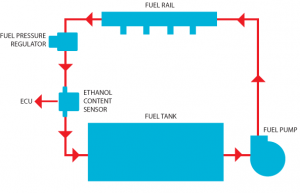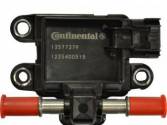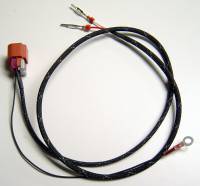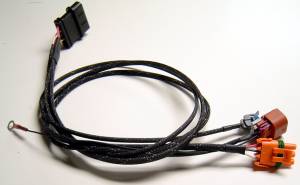Table of Contents
Ethanol sensor support page
Ethanol sensors report ethanol content as a frequency from 50hz to 150hz corresponding to 0% and 100% ethanol. ECMLink can be configured to use the ECU's MAF input to read an ethanol sensor's output and then adjust the fuel mixture accordingly. ECMLink can also be configured to interpolate between the MinOct and MaxOct timing and fuel tables based on ethanol content.
Doing this requires speed density operation so as to free up the MAF input for the ethanol sensor signal and, clearly, you have to add an ethanol sensor installed as well. The sensor is typically installed on the return side of the fuel pressure regulator (i.e., between the fuel pressure regulator and the tank).
Due to variations in fuel system setup, the exact details of the physical installation will vary from one car to the next. So this page doesn't spend much time going over all those different options. We cover a few basics with the two most common configurations, but other than that, you'll need to carefully consider the particulars of your specific setup to determine the best option.
This page primarily focuses on the theory and software configuration options supported in ECMLink so that you have a good understanding of how ECMLink works with ethanol sensor data.
Physical installation
 First, to help with the installation process, we have collected together various part numbers and such on our Ethanol sensor parts list reference page. That page also includes links to some sample installation examples from various other places on the web including this overview picture show to the right (click to enlarge).
First, to help with the installation process, we have collected together various part numbers and such on our Ethanol sensor parts list reference page. That page also includes links to some sample installation examples from various other places on the web including this overview picture show to the right (click to enlarge).
Although there are probably a variety of different ways to run a fuel return system in a DSM, the two most common have either stock rubber hose or AN lines (typically -6AN) running from the fuel pressure regulator to the tank.
If you have a fairly stock return setup, then you should be able to get by without adapters. The factory rubber line is 6mm (1/4“) ID, but a little heat will allow you to slip the hose over the 3/8” sensor barbs.
If you have an AN setup, then you'll need some way to adapt the sensor hardlines to the AN lines. The typical solution is a hard tube push-on fitting like the Russell adapter listed on our Ethanol sensor parts list page. These adapters push onto the ethanol sensor to basically convert the ends to AN fittings.
Once you've determined how to tee into your sensor into the fuel line, you'll need to decide how to wire it to the ECU.
Wiring
 The ethanol sensor has three pins: +12v, chassis ground and signal to the ECU. Conveniently, these pins are actually labeled on the sensor itself! Click on the image to the right to see these labels. Very nice. The manufacturer did not have to do that for us as these sensors are typically installed in production vehicles where there's no need for such information.
The ethanol sensor has three pins: +12v, chassis ground and signal to the ECU. Conveniently, these pins are actually labeled on the sensor itself! Click on the image to the right to see these labels. Very nice. The manufacturer did not have to do that for us as these sensors are typically installed in production vehicles where there's no need for such information.
Our Ethanol sensor parts list page has links to the connector and pins needed to fit to this sensor. But we also offer a simple modification to our SD cable that provides this connection for you. The adapter looks like the one shown below (click to enlarge) and simply snaps into the MAF connector on the SD cable.
Once that's snapped into place, you'll have an SD cable with an IAT connector, a MAP connector and an ethanol sensor connector like shown below (click to enlarge).
If you're not running our SD cable, then the easiest option is to simply get the EFI Connection Part # 100-00741 pigtail and just wire it straight up yourself.
The ground connection needs to be run to chassis ground (i.e., do not use sensor ground off the TPS or MAF connector).
The power connection (labeled “Vcc”) needs to run to a switched +12v source. You can find a convenient switched +12v source on the MAF connector harness. This will be a thick red wire on pin 3 of a 1G MAF connector or pin 4 of a 2G/EVO3 MAF connector.
The signal wire (labeled “Out”) needs to run to the ECU's MAF input. This is pin 2 (green with blue stripe) on a 1G MAF connector or pin 3 (blue with yellow stripe) on a 2G/EVO3 MAF connector.
Operation
Log values
Once the sensor is installed and connected to the ECU, you can datalog various ethanol-related parameters to confirm operation even before you enable ethanol sensor operation in ECMLink. You can also view these parameters without starting the engine! Simply activate the fuel pump off the Misc tab to circulate fuel through the ethanol sensor so that you can test and adjust settings before starting the engine.
| Log parameter | Description |
|---|---|
| FlexFreq | Displays the sampled frequency from the ethanol sensor. |
| FlexEthMix | Displays the ethanol content reported from the sensor as a percentage. A number like 85% indicates an 85% concentration of ethanol in the fuel. |
| FlexOctWeight | Displays the weighting given to the MaxOct tables based on ethanol content. A value of 100% means the MaxOct table is being used exclusively with no influence from the MinOct tables. A value of 50% means the MinOct and MaxOct tables are being averaged equally. |
| FlexFuelAdj | Displays the amount of fuel adjustment to be applied based on ethanol content and the ECU's configuration. A value of 0% would mean that no ethanol-related enrichment is being applied. A value of 50% means a 50% ethanol-related enrichment will be applied in the final injector pulse width calculation. Typical values for FlexFuelAdj are somewhere from around 6% for E10 and maybe 55% for E85. But this all depends on other parameters described below. |
Settings
The ethanol sensor settings are accessed in the AuxMaps tab in the ECU Config area.

Enable ethanol sensor (speed density operation and ethanol sensor required)
Enables basic ethanol sensor functionality (i.e., automated global fuel adjustment). Once checked, the ECU will start sampling the MAF input for a valid ethanol sensor signal and once found will apply an ethanol-based adjustment to the global fuel scalar defined on the Fuel tab.
Fuel increase at E100
Defines the enrichment value to apply when the ethanol sensor reports 100% ethanol content. When the ethanol sensor reports 0% ethanol, no adjustment is done. A theoretically correct value for the E100 enrichment is around 63%. So that's a good value to start with. But we've found in testing that various injectors actually flow less volume with increasing ethanol content. So you may find that you need to increase this enrichment if your mixture seems to get a little leaner as you increase the ethanol content of your fuel.
Interpolate between Min and Max octane based on ethanol content
When checked, the ECU will interpolate between the MinOct and MaxOct tables based on ethanol content (i.e., based on the value reported by FlexEthMix). You define the two end points where MinOct and MaxOct are used and then the ECU interpolates between the two any time the ethanol content reported by the sensor lies betweent those two end points.
Typical values would be to use MinOct at E10 (10% ethanol) and then MaxOct at E85 (85% ethanol). But this is entirely up to you, as the tuner, how you want to go. Some guys like to be running on the max tune by the time they have an E50 mix. In that case, they can just put 50% into the Use MaxOct at & above field.
UseMinOct at & below
Specifies the ethanol content at which the MinOct maps will be used exclusively with no influence from the MaxOct maps. Any ethanol percentage at or below the value specified in this field will force the use of MinOct maps exclusively.
UseMaxOct at & above
Specifies the ethanol content at which the MaxOct maps will be used exclusively with no influence from the MinOct maps. Any ethanol percentage at or above the value specified in this field will force the use of MaxOct maps exclusively.
Calculating global fuel scale
One thing that was mentioned above in the “Fuel increase at E100” section but might not have been clear is that you need to specify your global fuel adjustment on the Fuel tab assuming a 0% ethanol content. So before you first enable ethanol sensor compensation, you're going to need to adjust your current global scale value according to the ethanol content of the fuel currently installed in your tank to make it correspond to a 0% content value.
To do that, you'll manually kick the fuel pump on using the button on the Misc tab, let the fuel circulate for a few seconds and then view the FlexFuelAdj log value to see how much of an adjustment ECMLink is going to make to your global fuel scale once enabled. Then you're just going to “undo” that adjustment on the global fuel scale so that once the adjustment is enabled, you'll end up right back where you started. This ensures a consistent transition away from having no automatic ethanol adjustment. An example will surely clear this up.
Example: Current global fuel = -40.5% before installing the ethanol sensor. Once installed and the fuel pump is run for a few seconds, FlexFuelAdj reads +35.9%.
STEP 1: New global = (current global + 1) / (FlexFuelAdj + 1) - 1
STEP 2: New global = (-0.405 + 1) / (0.359 + 1) - 1
STEP 3: New global = 0.595 / 1.359 - 1
STEP 4: New global = 0.438 - 1
STEP 5: New global = -0.562 or -56.2%
So you would change the -40.5% global fuel to -56.2% before enabling the ethanol sensor adjustment in ECMLink.


